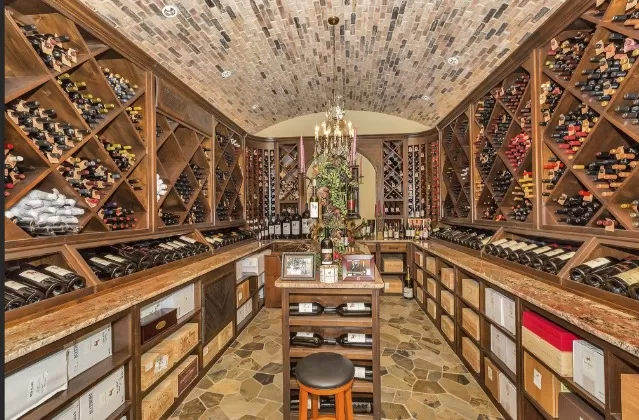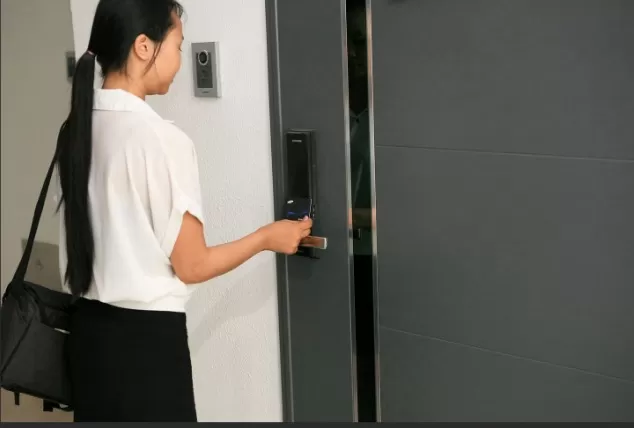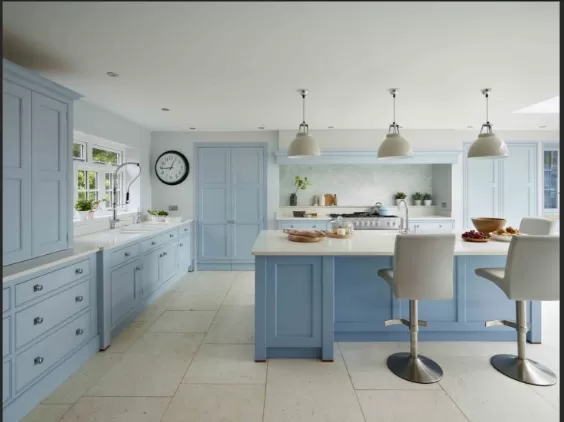Ceiling Wallpaper 101: Things to Know Before You Embark. When it comes to choosing the perfect type, color, and pattern for wallpapering your ceiling, there are a few factors to consider.
Ensuring an Ideal Ceiling for Wallpaper Application: A Guide to Surface Preparation and Alternatives for Flawless Results

If you’re planning to use wallpaper as a means to conceal imperfections on your ceiling, it’s crucial to begin with a surface that is smooth, clean, and structurally sound.
Neglecting this initial step can lead to numerous complications down the line. This is especially true if you reside in an older house where the ceiling is prone to developing cracks, as applying wallpaper may cause it to buckle as these cracks expand over time.
Moreover, popcorn ceilings present another challenge when it comes to using wallpaper as a wall covering option. Not only is it difficult for the paper to adhere properly, but the textured surface will likely show through, resulting in an unsatisfactory outcome.
Instead of relying solely on wallpaper, it’s worth exploring alternative decorative options that offer greater durability for your ceiling.
Consider incorporating features such as beadboard, exposed wood beams, or embossed tin. These alternatives not only provide a visually appealing aesthetic but also serve as more resilient choices for adorning your ceiling.
By opting for these alternatives, you can ensure a long-lasting and visually pleasing ceiling that enhances the overall ambiance of your space.
Selecting the Perfect Wallpaper: Exploring Different Types and Considerations
When it comes to choosing the right wallpaper, it’s essential to consider your preferences, the ease of application, and the desired longevity of the wallpaper.
In the present market, there are three primary types of wallpaper to choose from:.
Traditional Wallpaper: This type of wallpaper requires the application of glue during the installation process.
While it may be a more labor-intensive option, traditional wallpaper often offers a wide range of patterns, designs, and textures to suit various aesthetic preferences.
Pre-Glued Wallpaper: A relatively simpler alternative, pre-glued wallpaper comes with an adhesive backing that activates when water is applied.
This process eliminates the need for separate glue application. While it is easier to work with than traditional wallpaper, it still requires careful handling and proper activation of the paste.
Removable Wallpaper: Also known as temporary or peel-and-stick wallpaper, this type offers the easiest installation and removal process.
With a peel-off backing, it can be effortlessly applied and taken down without leaving residue or causing damage to the underlying surface. However, it’s important to note that removable wallpaper may not have the same durability as high-quality traditional papers, and the selection of patterns and designs might be more limited.
Fortunately, if you have a specific pattern or design in mind, there are companies like Spoonflower.
com that allow you to create your own custom wallpaper. This way, you can unleash your creativity and ensure a unique and personalized touch to your living space.
Consider your priorities in terms of ease of installation, longevity, and design options when choosing the type of wallpaper that best suits your needs.
Whether you opt for the classic appeal of traditional wallpaper, the convenience of pre-glued wallpaper, or the versatility of removable wallpaper, there is a wide array of choices available to transform your space with style and creativity.
Planning for Wallpaper Removal: Simplifying the Process and Exploring Options

While wallpaper can add beauty and personality to your space, it’s important to keep in mind that trends and personal preferences may change over time.
Eventually, you may find yourself wanting to remove the wallpaper and explore new design possibilities. Here are some considerations and options to facilitate the removal process:.
Choose a Timeless Style: When selecting wallpaper, it’s wise to opt for a style that has the potential to age well.
This is particularly crucial for rooms like children’s bedrooms, where motifs and patterns that cater to younger ages may become outdated as your child grows older. By choosing a timeless design, you can minimize the need for frequent wallpaper removal.
Removable Wallpaper: If you anticipate that you might grow tired of the chosen wallpaper or desire more flexibility in changing your décor, removable wallpaper is an excellent choice.
Unlike traditional wallpaper, which requires extensive effort to remove, removable wallpaper is specifically designed to peel off easily. This spares you from the arduous task of steaming and scouring to loosen the adhesive.
With removable wallpaper, you can effortlessly update your space without the hassle of labor-intensive removal methods.
Proper Removal Techniques: If you have traditional wallpaper installed and plan to remove it, it’s crucial to employ the right techniques to simplify the process.
Start by scoring the wallpaper with a scoring tool to create small perforations, allowing the removal solution to penetrate. Then, apply a wallpaper removal solution or fabric softener mixed with warm water to loosen the adhesive.
This will make it easier to peel or scrape off the wallpaper. Take care during the process to avoid damaging the underlying surface.
By considering these aspects and selecting the appropriate type of wallpaper, you can simplify the future removal process.
Whether you choose a timeless design or opt for removable wallpaper, you’ll have more flexibility in adapting your space to evolving styles and preferences without the added difficulty of extensive removal procedures.
Leveraging Wallpaper for Architectural Enhancement: Maximizing the Potential of Different Room Features
When considering the use of wallpaper in your home, it’s important to recognize that certain rooms and architectural features present unique opportunities for creative expression.
By strategically applying wallpaper, you can make the most of these spaces and elements. Here are some scenarios where using wallpaper on the ceiling can be advantageous:.
Kitchens and Utility Spaces: Rooms such as kitchens and utility areas often have limited wall space due to cabinetry and large appliances.
In such cases, utilizing ceiling wallpaper can be a smart choice. By extending the wallpaper to the ceiling, you can add a touch of color, pattern, or texture to the space, transforming it into a visually appealing and cohesive environment.
Rooms with Multiple Doors, Windows, or Shelving: Rooms that have an abundance of doors, windows, or shelving can sometimes make wall decoration challenging.
However, by diverting attention to the ceiling through wallpaper, you can create a focal point and add visual interest to the room. This approach allows you to work with the available space and architectural features, enhancing the overall aesthetic appeal.
Top-Floor Rooms with Dormers: Top-floor rooms with dormers often have unique and sometimes awkward angles that can be challenging to decorate.
Wallpapering the ceiling in such rooms can cleverly disguise these angles and create a cohesive look. By extending the wallpaper onto the ceiling, you can create a harmonious and visually pleasing atmosphere while minimizing the impact of the room’s architectural quirks.
When considering these scenarios, it’s important to select wallpaper designs, colors, and patterns that complement the overall style and function of the space.
By leveraging the architectural advantages of different rooms, you can use wallpaper to transform your home into a personalized and visually stunning environment.
Careful Selection of Color and Pattern: Impacting the Ambiance and Visual Balance of the Space

When choosing the color and pattern of your wallpaper, it’s essential to consider their influence on the overall atmosphere and visual appeal of the room.
Here are some key factors to keep in mind:
Color Choice: The color of the wallpaper can significantly impact the mood and perception of the space. Darker tones on the ceiling can create a cozy and intimate ambiance, ideal for rooms where a warm and snug feel is desired.
On the other hand, lighter colors can make smaller rooms appear more spacious and open.
Additionally, metallic tones can help reflect light in cramped areas, making them feel brighter and more inviting.
Pattern Scale: The scale of the pattern is an important consideration.
Larger-scale patterns, with a repeat of 12 inches or more, can be visually pleasing and easier on the eye, particularly in rooms where you want to create a focal point. They can add a sense of drama and elegance to the space.
However, if you’re a DIY enthusiast and concerned about the precision of installation, smaller-scale patterns can be more forgiving as they help disguise misalignments during the installation process.
Balance with Décor: It’s crucial to strike a balance between the wallpaper’s pattern and the rest of the room’s décor.
If you choose a bold, small-scale pattern for the wallpaper, consider keeping the furniture and other elements of the room simpler and more understated. This will prevent the space from feeling overly busy or visually overwhelming.
On the other hand, if you opt for a larger-scale pattern, you can introduce complementary décor elements to enhance the overall aesthetic.
Ultimately, the color and pattern you choose should align with your personal style and the desired ambiance of the room.
Consider the size and purpose of the space, as well as the amount of natural light it receives, to make an informed decision. By carefully selecting the color and pattern, you can create a harmonious and visually captivating environment that reflects your unique taste and vision.
*The information is for reference only.